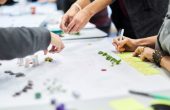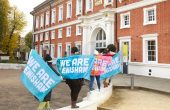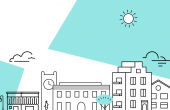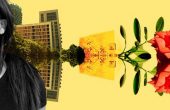Mile End might not be everyone’s first choice destination when it comes to connecting with the natural world. However, just minutes away from the A11, nestled in the Mile End Park, is an Art Pavilion.
The Pavilion, almost hidden as it is sheltered under a grass bank, is a tranquil hideaway, with a large glass frontage looking out on a small lake, and just a short walk from the local Ecology Park.
It is a fitting location for ‘Force of Nature’, an exhibition curated by James Putnam, Research Fellow at London College of Fashion, which looks at how different artists are inspired and respond to the natural world.

The exhibition features 28 contemporary artists, who each explore nature’s processes such as birth, growth, movement, light, decay, evolution and rebirth.
I tend to enjoy exhibitions which revolve around a simple central theme such as this. Nature is such an accessible and common influencer in all of our lives, it gives the exhibition a very focussed yet unintimidating feel.
This is helped further by its location within Mile End Park. The visitors have largely been locals, who pop into the free gallery on their walks through the park, and there have also been visits from local schools. It felt refreshing to walk into a gallery with such a relaxed feel.
But that is not to diminish the significance and brilliance of the art inside. One of the first pieces to greet you as you walk into the gallery is James’ own piece ‘Suspended Animation’; a beautiful chain of flint stones suspended and linked together to create a sort of slowly shifting vertebral column.

As your gaze drifts beyond the sculpture, you are drawn to the pond that envelopes the gallery, within it sits a nest of large glass eggs created by Koen Vanmechelen, challenging our perception of “natural”.
Birds are a recurrent source of inspiration throughout the exhibition, which features a taxidermy peacock with a native American headdress (Nancy Fouts), and one of the standout pieces is ‘Scuffle’ an enfolding sculpture by Kate MccGwire beautifully formed of pheasant feathers. The colours and patterns are amazing!
I also particularly liked Douglas White’s work, in which he records the grease and dust residue imprint left by the feathers of birds who have flown into windows! His piece ‘Owl’ records the imprint of a tawny owl with a stunning effect.

There is an incredible variety of both subject matter and medium throughout the show.
A re-pulped wasp’s nest is used by Alasdair Mackie to create a small but superb sculpture of a human heart, whilst Yuken Terya uses the pages of the New York Times to form miniature sculptures of trees.

There are also some inspiring photographic pieces. In Ruben Brulat’s photo of an active volcano in Ethiopia it’s easy to miss the tiny human figure of Brulat himself lying on the volcano’s edge. It’s a powerful expression of human vulnerability in the face of the powerful force of nature.
One piece I was particularly moved by was Susan Derges ‘photogram’ of water and ice flowing through the River Taw, created by placing photographic paper into the river itself, which reveals the beautiful patterns of flowing and freezing water. Unfortunately words can’t really do it justice, you’ll have to go to the exhibition and witness it for yourself!

I can’t recommend this show enough. In a tranquil, accessible setting; free and full of inspiration, Force of Nature reminds us of our own close relationship to the natural world.
Humans are very much part of nature and through the artist’s observation and work, we can understand more about not only nature, but of the human condition within nature.
Force of Nature runs at The Art Pavilion in Mile End until Sunday 9th April.






